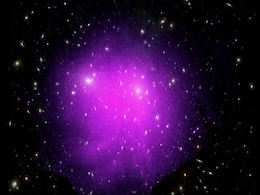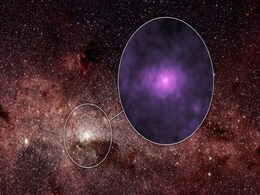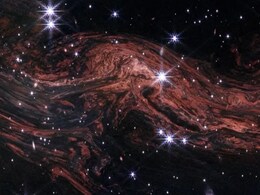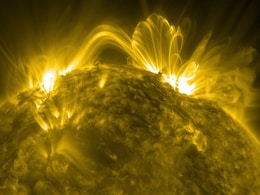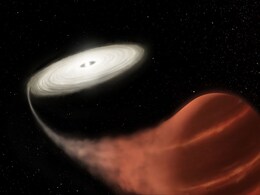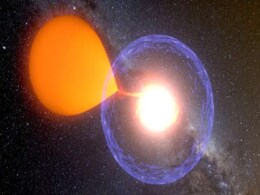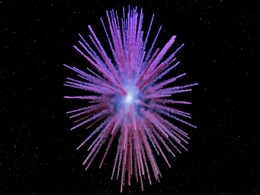Supernova Explosion
- All
- News
-

Supernova Remnants Found in Oceanic Samples, Scientists Look to Moon
- Wednesday March 26, 2025
- Written by Gadgets 360 Staff
Scientists have identified supernova debris in deep-sea sediments, including a rare plutonium isotope linked to a kilonova. Researchers believe a neutron star collision occurred nearly 10 million years ago, scattering radioactive material across space. To validate this theory, they plan to analyze lunar soil, which remains undisturbed by Earth's ge...
-
 www.gadgets360.com
www.gadgets360.com
-

Hubble Spots Distant Supernova in Gemini, Enhancing Cosmic Distance Studies
- Tuesday February 4, 2025
- Written by Gadgets 360 Staff
The NASA/ESA Hubble Space Telescope has captured a stunning image of SN 2022aajn, a Type Ia supernova in the constellation Gemini. Located 600 million light-years away, the explosion was first detected in November 2022. Type Ia supernovae serve as essential cosmic distance markers due to their predictable brightness. Hubble’s observations, part o...
-
 www.gadgets360.com
www.gadgets360.com
-

Vera C. Rubin Observatory to Detect Millions of Exploding Stars
- Wednesday January 29, 2025
- Written by Gadgets 360 Staff
The Vera C. Rubin Observatory, set to begin its 10-year Legacy Survey of Space and Time (LSST) later this year, will track millions of Type Ia supernovae to advance our understanding of dark energy. These supernovae, resulting from white dwarf stars in binary systems, will be studied in detail to provide crucial data on the universe’s acceleratin...
-
 www.gadgets360.com
www.gadgets360.com
-

Early Supernovas Could Have Created Water in the Universe, Paving the Way for Life 100 Million Years Post-Big Bang
- Friday January 24, 2025
- Written by Gadgets 360 Staff
A recent study suggests that supernova explosions, triggered by the death of early stars, could have created significant amounts of water just 100 million years after the Big Bang. Simulations of these early, massive stars show that their explosive deaths may have resulted in the formation of water molecules within the dense hydrogen and oxygen clo...
-
 www.gadgets360.com
www.gadgets360.com
-

Coma Cluster’s Distance Closer Than Predicted, Amplifying Hubble Tension Crisis
- Friday January 24, 2025
- Written by Gadgets 360 Staff
A new study led by Dan Scolnic and Adam Riess reveals that the Coma Cluster is 38 million light-years closer than predicted by standard cosmological models, intensifying the ongoing Hubble tension. This discrepancy, involving measurements of type Ia supernova explosions, challenges the universe's expansion rate as predicted by the Hubble–Lemaîtr...
-
 www.gadgets360.com
www.gadgets360.com
-

Zombie Star’s Mysterious Spiky Filaments Baffle Astronomers in New Discovery
- Thursday January 23, 2025
- Written by Gadgets 360 Staff
A zombie star remnant, Pa 30, located 6,500 light-years from Earth, is surrounded by spiky filaments that have baffled astronomers. These filaments, observed for centuries, continue to puzzle scientists, as their formation and long-term stability remain unclear. The star's explosion in 1181 was initially noted by skywatchers, but its remnant struct...
-
 www.gadgets360.com
www.gadgets360.com
-

James Webb Space Telescope Unveils Hidden Interstellar Wonders of Supernova Cassiopeia A
- Friday January 17, 2025
- Written by Gadgets 360 Staff
The James Webb Space Telescope has provided a rare glimpse into the remnants of a centuries-old supernova in Cassiopeia A. Using infrared technology, the telescope captured a light echo caused by a massive star’s explosion, unveiling new insights into the interstellar medium and its magnetic structures. This breakthrough discovery offers valuable...
-
 www.gadgets360.com
www.gadgets360.com
-

James Webb Space Telescope Detects Supernova From 11.4 Billion Years Ago
- Friday January 17, 2025
- Written by Gadgets 360 Staff
Astronomers using the James Webb Space Telescope (JWST) have identified AT 2023adsv, a supernova that occurred 11.4 billion years ago. This stellar explosion, from a star 20 times the size of the Sun, offers a glimpse into the early universe's unique stellar evolution. Part of the JWST Advanced Deep Extragalactic Survey, the event highlights how th...
-
 www.gadgets360.com
www.gadgets360.com
-

White Dwarf’s Unexplainable Rapid Spin Finally Decoded by Scientists
- Tuesday January 14, 2025
- Written by Gadgets 360 Staff
The white dwarf star RX J0648.0–4418, 1,700 light-years away, spins at a rapid pace of 13 seconds per rotation. Part of a binary system with a helium-burning hot subdwarf star, it continues to shrink while accreting material. This rare and short-lived system provides a unique view into stellar evolution. Approaching the Chandrasekhar limit, RX J0...
-
 www.gadgets360.com
www.gadgets360.com
-

Supernova Remnant G278.94+1.35 is Closer to Earth, Claims New Study
- Friday January 10, 2025
- Written by Gadgets 360 Staff
Astronomers discovered that the supernova remnant G278.94+1.35 is located just 3,300 light years away, much closer than previously believed. Initially thought to span over 500 light years, it is now estimated to measure around 189 by 182 light years. Named "Diprotodon" after Australia’s extinct giant marsupial, this structure remains in an expand...
-
 www.gadgets360.com
www.gadgets360.com
-

Astronomers Spot New Cosmic Explosions 100 Times Brighter Than the Sun
- Wednesday December 25, 2024
- Written by Gadgets 360 Staff
Astronomers have discovered a new class of cosmic explosions, known as 'millinovas,' which are 100 times brighter than the Sun. These events, first identified in 2023, were observed in the Large and Small Magellanic Clouds, two satellite galaxies of the Milky Way. The millinovas are thought to occur when white dwarfs feed off a companion star, prod...
-
 www.gadgets360.com
www.gadgets360.com
-

Scientists Develop New Approach to Capture Gravitational Wave Memory from Supernovae
- Wednesday December 18, 2024
- Written by Gadgets 360 Staff
A study published in Physical Review Letters highlights new methods to detect the gravitational wave memory effect, a unique phenomenon predicted by Einstein's general relativity. Core-collapse supernovae (massive stellar explosions) generate these low-frequency gravitational waves, offering a rare glimpse into stellar interiors. Despite their weak...
-
 www.gadgets360.com
www.gadgets360.com
-

Could a Supernova Threaten Earth’s Survival? Here's What You Need to Know
- Friday November 15, 2024
- Written by Gadgets 360 Staff
Supernova explosions have the potential to harm Earth’s atmosphere, particularly the ozone layer. However, no stars close enough to cause damage are currently identified. The risks are low, but gamma-ray bursts, caused by neutron star mergers, may pose an even greater threat in the future.
-
 www.gadgets360.com
www.gadgets360.com
-

Astronomers Observe Black Hole That May Have Formed Gently
- Tuesday October 29, 2024
- World News | Reuters
The conventional wisdom among astronomers is that black holes - those exceptionally dense objects with gravity so powerful that not even light can escape - form in the violent explosion, called a supernova, of a massive dying star.
-
 www.ndtv.com
www.ndtv.com
-

Supernova SN 1181 Reveals Rare “Zombie Star” in Pa 30 Nebula
- Monday October 28, 2024
- Written by Gadgets 360 Staff
A supernova recorded in 1181, known as SN 1181, has been linked to the Pa 30 nebula, revealing a rare “zombie star.” Advanced 3D imaging from the Keck Observatory has shown unusual filaments expanding from this star, marking it as a unique case in supernova studies. This zombie star survived a thermonuclear explosion on a white dwarf, challengi...
-
 www.gadgets360.com
www.gadgets360.com
-

Supernova Remnants Found in Oceanic Samples, Scientists Look to Moon
- Wednesday March 26, 2025
- Written by Gadgets 360 Staff
Scientists have identified supernova debris in deep-sea sediments, including a rare plutonium isotope linked to a kilonova. Researchers believe a neutron star collision occurred nearly 10 million years ago, scattering radioactive material across space. To validate this theory, they plan to analyze lunar soil, which remains undisturbed by Earth's ge...
-
 www.gadgets360.com
www.gadgets360.com
-

Hubble Spots Distant Supernova in Gemini, Enhancing Cosmic Distance Studies
- Tuesday February 4, 2025
- Written by Gadgets 360 Staff
The NASA/ESA Hubble Space Telescope has captured a stunning image of SN 2022aajn, a Type Ia supernova in the constellation Gemini. Located 600 million light-years away, the explosion was first detected in November 2022. Type Ia supernovae serve as essential cosmic distance markers due to their predictable brightness. Hubble’s observations, part o...
-
 www.gadgets360.com
www.gadgets360.com
-

Vera C. Rubin Observatory to Detect Millions of Exploding Stars
- Wednesday January 29, 2025
- Written by Gadgets 360 Staff
The Vera C. Rubin Observatory, set to begin its 10-year Legacy Survey of Space and Time (LSST) later this year, will track millions of Type Ia supernovae to advance our understanding of dark energy. These supernovae, resulting from white dwarf stars in binary systems, will be studied in detail to provide crucial data on the universe’s acceleratin...
-
 www.gadgets360.com
www.gadgets360.com
-

Early Supernovas Could Have Created Water in the Universe, Paving the Way for Life 100 Million Years Post-Big Bang
- Friday January 24, 2025
- Written by Gadgets 360 Staff
A recent study suggests that supernova explosions, triggered by the death of early stars, could have created significant amounts of water just 100 million years after the Big Bang. Simulations of these early, massive stars show that their explosive deaths may have resulted in the formation of water molecules within the dense hydrogen and oxygen clo...
-
 www.gadgets360.com
www.gadgets360.com
-

Coma Cluster’s Distance Closer Than Predicted, Amplifying Hubble Tension Crisis
- Friday January 24, 2025
- Written by Gadgets 360 Staff
A new study led by Dan Scolnic and Adam Riess reveals that the Coma Cluster is 38 million light-years closer than predicted by standard cosmological models, intensifying the ongoing Hubble tension. This discrepancy, involving measurements of type Ia supernova explosions, challenges the universe's expansion rate as predicted by the Hubble–Lemaîtr...
-
 www.gadgets360.com
www.gadgets360.com
-

Zombie Star’s Mysterious Spiky Filaments Baffle Astronomers in New Discovery
- Thursday January 23, 2025
- Written by Gadgets 360 Staff
A zombie star remnant, Pa 30, located 6,500 light-years from Earth, is surrounded by spiky filaments that have baffled astronomers. These filaments, observed for centuries, continue to puzzle scientists, as their formation and long-term stability remain unclear. The star's explosion in 1181 was initially noted by skywatchers, but its remnant struct...
-
 www.gadgets360.com
www.gadgets360.com
-

James Webb Space Telescope Unveils Hidden Interstellar Wonders of Supernova Cassiopeia A
- Friday January 17, 2025
- Written by Gadgets 360 Staff
The James Webb Space Telescope has provided a rare glimpse into the remnants of a centuries-old supernova in Cassiopeia A. Using infrared technology, the telescope captured a light echo caused by a massive star’s explosion, unveiling new insights into the interstellar medium and its magnetic structures. This breakthrough discovery offers valuable...
-
 www.gadgets360.com
www.gadgets360.com
-

James Webb Space Telescope Detects Supernova From 11.4 Billion Years Ago
- Friday January 17, 2025
- Written by Gadgets 360 Staff
Astronomers using the James Webb Space Telescope (JWST) have identified AT 2023adsv, a supernova that occurred 11.4 billion years ago. This stellar explosion, from a star 20 times the size of the Sun, offers a glimpse into the early universe's unique stellar evolution. Part of the JWST Advanced Deep Extragalactic Survey, the event highlights how th...
-
 www.gadgets360.com
www.gadgets360.com
-

White Dwarf’s Unexplainable Rapid Spin Finally Decoded by Scientists
- Tuesday January 14, 2025
- Written by Gadgets 360 Staff
The white dwarf star RX J0648.0–4418, 1,700 light-years away, spins at a rapid pace of 13 seconds per rotation. Part of a binary system with a helium-burning hot subdwarf star, it continues to shrink while accreting material. This rare and short-lived system provides a unique view into stellar evolution. Approaching the Chandrasekhar limit, RX J0...
-
 www.gadgets360.com
www.gadgets360.com
-

Supernova Remnant G278.94+1.35 is Closer to Earth, Claims New Study
- Friday January 10, 2025
- Written by Gadgets 360 Staff
Astronomers discovered that the supernova remnant G278.94+1.35 is located just 3,300 light years away, much closer than previously believed. Initially thought to span over 500 light years, it is now estimated to measure around 189 by 182 light years. Named "Diprotodon" after Australia’s extinct giant marsupial, this structure remains in an expand...
-
 www.gadgets360.com
www.gadgets360.com
-

Astronomers Spot New Cosmic Explosions 100 Times Brighter Than the Sun
- Wednesday December 25, 2024
- Written by Gadgets 360 Staff
Astronomers have discovered a new class of cosmic explosions, known as 'millinovas,' which are 100 times brighter than the Sun. These events, first identified in 2023, were observed in the Large and Small Magellanic Clouds, two satellite galaxies of the Milky Way. The millinovas are thought to occur when white dwarfs feed off a companion star, prod...
-
 www.gadgets360.com
www.gadgets360.com
-

Scientists Develop New Approach to Capture Gravitational Wave Memory from Supernovae
- Wednesday December 18, 2024
- Written by Gadgets 360 Staff
A study published in Physical Review Letters highlights new methods to detect the gravitational wave memory effect, a unique phenomenon predicted by Einstein's general relativity. Core-collapse supernovae (massive stellar explosions) generate these low-frequency gravitational waves, offering a rare glimpse into stellar interiors. Despite their weak...
-
 www.gadgets360.com
www.gadgets360.com
-

Could a Supernova Threaten Earth’s Survival? Here's What You Need to Know
- Friday November 15, 2024
- Written by Gadgets 360 Staff
Supernova explosions have the potential to harm Earth’s atmosphere, particularly the ozone layer. However, no stars close enough to cause damage are currently identified. The risks are low, but gamma-ray bursts, caused by neutron star mergers, may pose an even greater threat in the future.
-
 www.gadgets360.com
www.gadgets360.com
-

Astronomers Observe Black Hole That May Have Formed Gently
- Tuesday October 29, 2024
- World News | Reuters
The conventional wisdom among astronomers is that black holes - those exceptionally dense objects with gravity so powerful that not even light can escape - form in the violent explosion, called a supernova, of a massive dying star.
-
 www.ndtv.com
www.ndtv.com
-

Supernova SN 1181 Reveals Rare “Zombie Star” in Pa 30 Nebula
- Monday October 28, 2024
- Written by Gadgets 360 Staff
A supernova recorded in 1181, known as SN 1181, has been linked to the Pa 30 nebula, revealing a rare “zombie star.” Advanced 3D imaging from the Keck Observatory has shown unusual filaments expanding from this star, marking it as a unique case in supernova studies. This zombie star survived a thermonuclear explosion on a white dwarf, challengi...
-
 www.gadgets360.com
www.gadgets360.com





